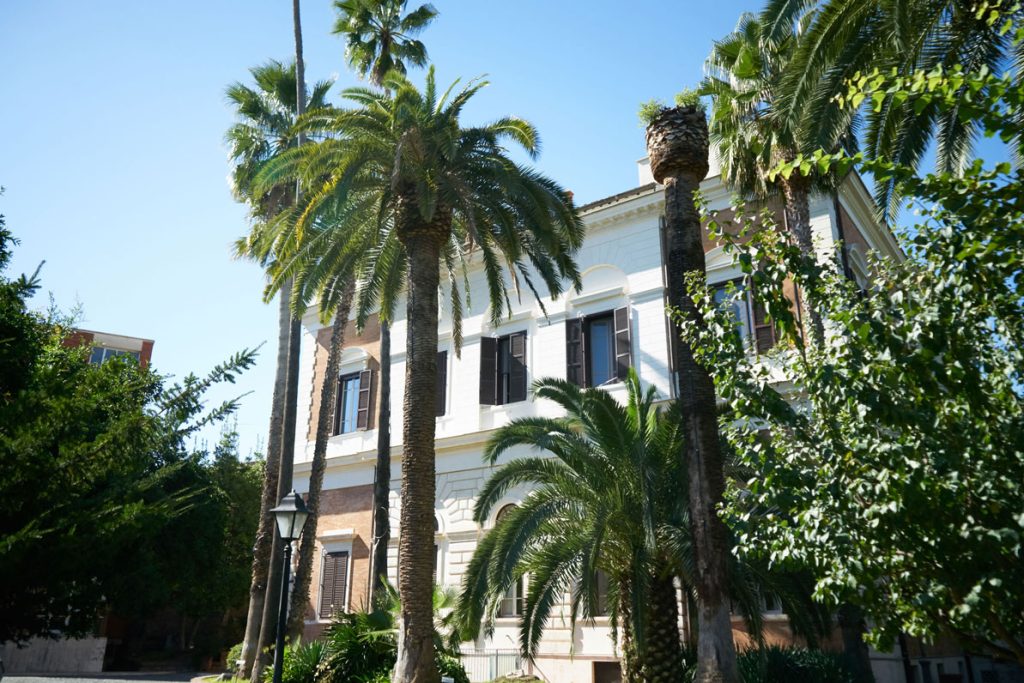Ultimo aggiornamento 26 July 2023

The Institute occupies an area of great historical-artistic interest, on the south-western slopes of the Viminale hill, with remains and testimonies dating back to Roman times. Since the Republican age and up to the late Empire, a neighborhood developed in the area with public buildings (Lavacrum Agrippinae and ThermaeOlimpis), private homes and rich patrician residences, abandoned between the 5th and 6th centuries when new basilicas were established in the area , first of all that of S. Maria Maggiore, completely modifying the urban fabric of the districts between Viminale and Esquilino.
In a plan of Rome engraved by Nolli in 1748, the current area occupied by ICPAL appears to belong to the Clarisse Nuns of San Lorenzo in Panisperna, with the convent and church dedicated to the Saint.
The day after 20 September 1870, when Rome became the capital of Italy, the transformation of the city into a large modern capital began. Based on a project by Quintino Sella, Minister of Finance, the Viminale area – following the expropriation by the State, in 1873, of the church and monastery of San Lorenzo – was destined to house the great Botanical Garden of Rome and the scientific and medical institutes of La Sapienza University. The works proceeded rapidly and many species of exotic or rare plants were planted on the hill, while the construction of new headquarters for the Institute of Physics and for that of Botany proceeded.
The project suffers a setback: the Municipality orders the opening of via Palermo and via Milano, which cuts the area in two. Therefore, in 1883 the Botanical Garden was transferred to its current location in Villa Corsini alla Lungara.
In 1913 the works for the building of the Ministry of the Interior on the Viminale began, bringing about a definitive change in the layout of the area. This was the last step that led in a few decades, in 1938, to the definitive transfer of the scientific institutes to the new site of the University City. In the same year, the area of the Institute of Botany and the Institute of Histology and Physiology was assigned to the Royal Institute of Book Pathology.
In the garden of the Institute, traces of the numerous urban transformations of the area remain. The main building of the ICPAL is located in the building that housed the Institute of Botany. In the historic garden that surrounds it, it is still possible to “read” the traces of the original Botanical Garden: in particular, some very rare plants survive, such as Aghatis and Araucaria, both native to Australia, and Phytolacca, native to Brazil and of Argentina and present in the garden in one of the few specimens imported by Prince Ladislao Odescalchi, a passionate botanist, on his return from a trip to South America.
Botanical Garden

In 1873 the Botanical Garden of Rome, following the arrangement of the Viminale area, was transferred to the headquarters in via Panisperna but remained there for only 10 years. The first news of a botanical garden in Rome dates back to the XIII century: its origin is linked to the figure of Pope Nicolò III (pope from 1277 to 1280) who transferred the papacy from S. Giovanni in Laterano to the Vatican, including in the Leonine walls also an area – the Pomerium – where there were plant, tree and herbaceous species.
In 1938 the newly established Royal Institute of Pathology of the Book took over the building where the Institute of Botany was located.
The ICPAL garden refers to the original botanical garden: in fact, rare and interesting essences grow there, such as, for example, the Phytolacca, native to Brazil and Argentina which Prince Ladislao Odescalchi, a passionate botanist, imported on his return from a trip to South America, at the end of the 19th century, together with two other specimens, today respectively in the garden of the Castle of Palo Laziale and on the ramp of the Ara Coeli church, in Rome.
Imposing is a specimen of Agathis, originally from Australia and New Zealand, considered sacred by the Maori. The straight and robust stem was used to make the masts of sailing ships. The widespread use of the prized timber has made it a rare species.
Araucaria, originally from the southern hemisphere, grows in Australia and South America. Of the species of conifers it produces huge pine cones that open, flaking and scattering large “pine nuts” on the ground.
Grevillea – widespread in the southern hemisphere – belongs to the proteaceae family, named after the demigod with transformative powers. In fact, the species that belong to it have different characteristics from each other.
Bamboo is the common name of several species of shrubs that have very curious characteristics. All specimens of the same species at any latitude flourish in the world at the same time and at unpredictable and absolutely irregular intervals (10, 20 or 100 years).

